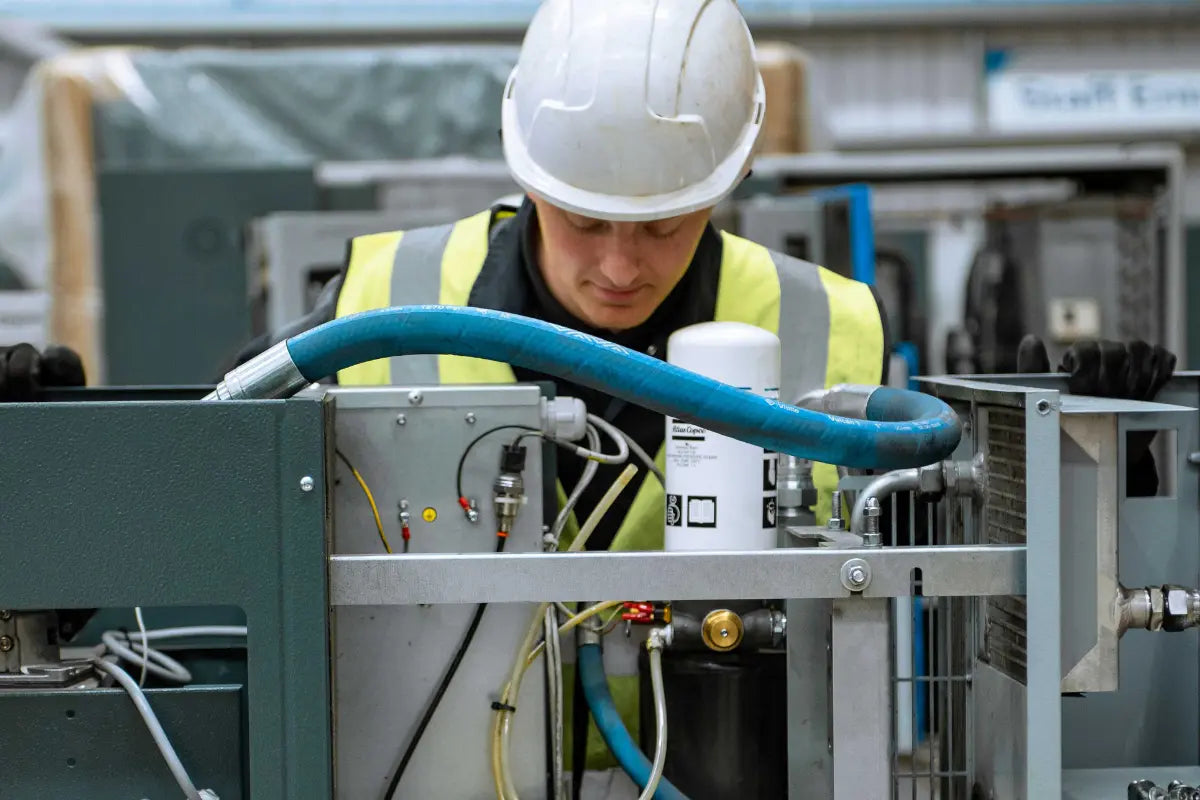Air is vital for life. Compressed air is vital for manufacturing.
Air is free. Compressed air is not.
Closely managing your air compressor servicing and maintenance is crucial for ensuring costs do not spiral, while ensuring operational efficiency and the longevity of your equipment. Especially, when you consider that maintenance costs account for 10% of the total life cycle cost of the equipment, alongside the initial purchase price and the energy costs.
In this article we will look at the four types of maintenance, what this relates to for air compressors and associated equipment and ideas for how to implement this.
What are the four types of maintenance?
1. Preventative Maintenance
Preventive maintenance involves scheduled inspections, cleaning, and servicing of equipment to prevent breakdowns and ensure smooth operation. This type of maintenance aims to identify and address potential issues before they cause costly downtime. Implementing a preventive maintenance program can help extend the life of your compressed air equipment and improve its overall efficiency. The challenge is predicting the exact timing of compressor maintenance and balancing out against compressor downtime.
The PPS air compressor maintenance checklist aims to give an overview of the tasks you should be including for weekly, monthly and quarterly preventive maintenance checks.
2. Corrective Maintenance
Corrective maintenance, also known as reactive maintenance, involves repairing your air compressor or ancillary equipment after a breakdown has occurred. This type of maintenance is performed in response to a specific issue or failure.
While corrective maintenance is essential for addressing immediate problems, relying solely on this approach can lead to increased downtime and higher repair costs.
3. Predictive Maintenance
Predictive maintenance for air compressors uses data and analytics to predict when there is likely to be a failure, so that maintenance can be performed proactively. By monitoring factors such as temperature, vibration, and energy consumption, you can predict potential failures and schedule maintenance tasks accordingly. Predictive maintenance can help reduce downtime, improve asset reliability, and optimise your maintenance resources.
A challenge of predictive maintenance is ensuring you have the right systems for data collection and analysis to accurately predict your maintenance tasks.
4. Condition-Based Maintenance
Condition-based maintenance is similar to predictive maintenance but focuses on monitoring specific conditions or parameters to determine when maintenance is required. For air compressors you would monitor motor performance, electrical connections, and air quality to detect early signs of potential issues. Condition-based maintenance can help minimize downtime, reduce maintenance costs, and extend the lifespan of equipment.
A challenge of this approach can be getting the balance right between monitoring the critical parameters and the cost of implementation and maintenance.
A combined approach to compressor maintenance hits the sweet spot

In practice, most companies use a combination of maintenance strategies for managing their compressed air systems. By integrating multiple maintenance approaches, you can address different aspects of maintenance needs and achieve a more comprehensive and effective maintenance program for your compressed air systems.
Here are a few reasons why you may choose to use a combination of compressed air maintenance strategies:
- Comprehensive maintenance coverage
Using a combination of preventive, corrective, predictive, and condition-based maintenance strategies ensures that you can address maintenance needs at different levels, from routine tasks to proactive monitoring and predictive maintenance.
- Risk Mitigation
By diversifying your maintenance approaches, you can mitigate the risks associated with relying solely on one type of maintenance strategy. This helps to reduce the likelihood of unexpected breakdowns and downtime.
- Optimised resource allocation
Implementing a mix of maintenance strategies allows companies to allocate resources more efficiently by targeting specific maintenance tasks based on the equipment condition, criticality, and budget considerations.
- Continuous improvement
Combining different maintenance strategies enables you to continuously improve your maintenance programs by leveraging the strengths of each approach and adapting to changing operational needs and equipment performance.
- Cost-effectiveness
A balanced mix of maintenance strategies can help you optimise maintenance costs by prioritising preventive actions, responding effectively to corrective needs, and leveraging predictive and condition-based maintenance to enhance reliability and efficiency.
So, a combined approach to compressor maintenance hits the sweet spot of reliability, efficiency, and cost-effectiveness in the long run.
Help to implement your air compressor maintenance strategy
Smartlink from Atlas Copco offers a compressed air monitoring system designed to enhance air compressor maintenance. By tracking essential indicators of compressed air installations on a weekly basis and providing real-time access to this data, Smartlink helps users maintain the performance of their machines. The service timeline within the Smartlink system displays the service requirements of each machine and schedules planned visits to ensure timely maintenance. This proactive approach to maintenance can help prevent unexpected breakdowns, optimise equipment efficiency, and extend the life of air compressors.
Additionally, Smartlink's connectivity solutions allow users to monitor maintenance requirements remotely and utilise IoT data to enhance uptime and energy efficiency. By actively monitoring over 30 data points, Smartlink enables users to make informed maintenance decisions and receive clear service reports to address potential issues promptly.
The PPS team have extensive experience in supporting manufacturing sites across a wide variety of industries, to implement effective maintenance strategies to optimise their efficiency and reliability. Compressor output is predicted to deteriorate by more than 10% without proper maintenance. Contact the team today if you have any questions.

